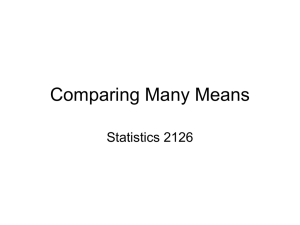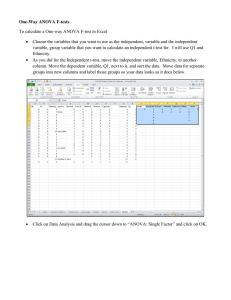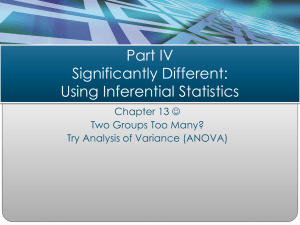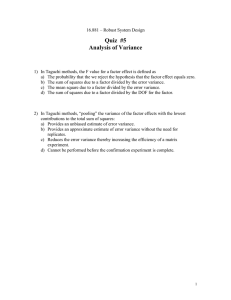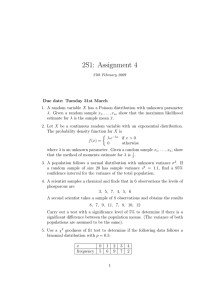Document 13509100
advertisement
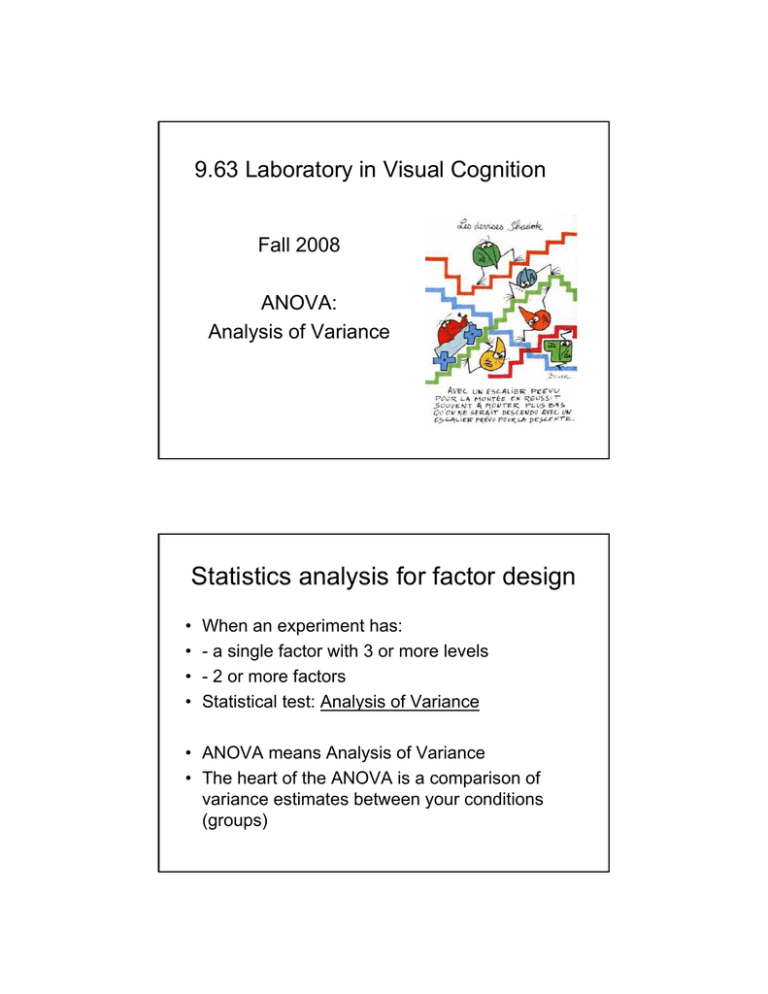
9.63 Laboratory in Visual Cognition Fall 2008 ANOVA: Analysis of Variance Statistics analysis for factor design • • • • When an experiment has: - a single factor with 3 or more levels - 2 or more factors Statistical test: Analysis of Variance • ANOVA means Analysis of Variance • The heart of the ANOVA is a comparison of variance estimates between your conditions (groups) 1 ANOVA • In the ANOVA, two independent estimates of variance are obtained: • (1) Between groups variance: based on the variability between the different experimental groups – how much the means of the different group differ from one another. Actually, the variance is computed as to how much the individual group means differ from the overall mean of all scores in the experiment. • (2) Within groups variance: give an estimate of how much the participants in a group differ from one another (or the mean of the group) ANOVA • Basic idea: are the scores of the different groups or conditions different from each other? • Null hypothesis: all the participants in the various conditions are drawn from the same population: the experimental variable has no effect. • Consequence of the null hypothesis on the between and within variance? 2 ANOVA • Basic idea: are the scores of the different groups or conditions different from each other? • Null hypothesis: all the participants in the various conditions are drawn from the same population: the experimental variable has no effect. • Consequence of the null hypothesis: the between group variance should be the same as the between group variance ANOVA • To reject the null hypothesis, the means of the different groups must vary from one another more than the scores vary within the groups • The greater the variance (differences) between the groups of the experiment, the more likely the independent variable is to have had an effect, especially if the within group variance is low • The F test is simply a ratio of the between groups variance estimate to the within-groups variance estimate Between-groups variance F = ---------------------------Within-groups variance 3 ANOVA • Under the null hypothesis, the F ratio should be ? Between-groups variance F = ---------------------------Within-groups variance ANOVA • Under the null hypothesis, the F ratio should be 1 • The greater the between groups variance is than the within group variance and consequently, the greater the F ratio is than 1.00, the more confident we can be in rejecting the null hypothesis. Between-groups variance F = ---------------------------Within-groups variance 4 Sources of Variability • Some of the variability comes from variability among subjects: how people differ from one another regardless of the experimental conditions (e.g. some subjects are slow, some subjects are faster) • Other variability is caused by the independent variables, which cause subjects to behave differently. ANOVA • Variance is simply a way to measure the differences between the scores (data) • ANOVA involves partitioning the variances: we take the total variability of the scores in an experiment and we break it up in terms of its sources 5 Sources of variance Variance between groups Total variance in the scores Variance within groups A toy case: Partitioning the variance e.g. an experiment with 9 subjects Frequency 1 2 3 4 5 6 7 8 9 Score (data) We see a certain amount of variability among the subjects, but we do not know how much is between groups variance and how much is within groups variance 6 If all the variance is between groups Group 1 Group 2 Group 3 4 5 6 7 8 G1 G2 G3 2 5 8 2 5 8 2 5 8 G1 G2 G3 2 2 2 5 5 5 8 8 8 9 If all the variance is within groups Group 1 Group 2 Group 3 7 Step : Heart of ANOVA Total variance In the scores Variance between Groups: mean square deviation between groups Variance within Groups: mean square deviation within groups Sources of variances Total variance In the scores Variance between Groups: mean square deviation between groups Variance within Groups: mean square deviation within groups 8 Variance between Groups: mean square deviation between groups Total variance In the scores The mean square between groups is an estimate of the difference in scores that occur between the levels in a factor (or independent variable A) Here, we find the difference between the mean of each condition and the overall mean of the study Level A1 (mean) Total variance In the scores Level A2 X X X X X X X X X X X1 X2 Overall X Variance within Groups: mean square deviation within groups The mean square within groups is an estimate of the variability in scores as measured by differences within the conditions of an experiment Here, we find the difference between each score in a condition and the mean of that condition 1) find the variance in level 1 2) find the variance in level 2 3) “pool” – average together – the variances -> We have the average variability of the scores in each condition around the mean of that condition Level A1 Level A2 X X X X X X X X X X X1 X2 (mean) (mean) 9 ANOVA The F test is a ratio of the between groups variance estimate to the within-groups variance estimate Between-groups variance estimate F = ---------------------------- Within-groups variance estimate The greater the between groups variance is than the within groups variance the greater F ratio is than 1.00 the more confident we can be in rejecting null hypothesis Effect of color on scene recognition • Question: does color help fast scene recognition? • Dependant variable: Reaction time to name the category of a scene • Factor 1: presence of color (color vs. gray) • Factor 2: Type of scenes • (man-made vs. natural) Man-made scenes Natural landscape scenes color Figures removed due to copyright restrictions. gray 10 Man-made & Natural Scenes • Man-made categories • City, Road, Room, Shop • Chrominance histograms => no specific colour mode • • • Natural categories Coast, Canyon, Desert, Forest Chrominance histograms => specific and distinctive colour modes Figures removed due to copyright restrictions. Organize the Reaction Time Means Main effect Man-made scenes Natural landscape scenes color 750 msec 771 msec gray Mean of factor “color” 746 msec 743 msec Main effect of factor “image type” Mean 742 msec 800 msec 742 msec 775 msec Figures removed due to copyright restrictions. 11 Graph the data Reaction time (msec) 820 800 780 color gray 760 740 720 700 680 man-made scene natural scene Error bars show 1 s.e.m (standard error mean) Experiment design • Three possible experimental designs: • Within group (repeated measures) • Between group • Mixte design 12 Case 1: All factors are within: 10 participants (a participant did all the conditions) Repeated-measures ANOVA Participant 1 Participant 10 Within-Subject or Repeated Measure ANOVA • Either the same participants are measured repeatedly • Either different participants are matched under all levels of one factor • Other assumptions of ANOVA: • 1) dependent variable is a ratio or interval factor • 2) populations data are normally distributed • 3) population variances are homogeneous 13 Case 2: All factors and conditions are between (a participant only do 1 condition): 40 participants (10 / conditions) Between-measures ANOVA Factor: scene type Factor: Color status Dep. Variable RT Participant 1 Participant N (e.g. 40) Case 3: A factor is between, a factor is repeated (one participant participates in all the conditions of one factor, but not in the conditions of the other factor). 20 participants Mixte-measures ANOVA Participant 1 Participant 20 14 Factorial design: 2 x 2 Scene types and color status • Main effect of Factor 1 (scene type: natural or man made): Is there a difference between the RT for recognizing “natural scene pictures” and RT for recognizing “man-made scenes pictures”? • A F and a p value for Factor 1 Factorial design: 2 x 2 Scene types and color status • Main effect of Factor 2 (color status: color or gray): Is there a difference between RT of naming “color pictures” and RT of naming “gray level pictures”? • A F and a p value for Factor 2 15 Factorial design: 2 x 2 Scene types and color status 820 800 color 780 gray 760 740 720 700 680 man-made scene natural scene • Interaction between scene type and color status: e.g. would the presence or absence of color only have an effect in the natural landscape condition? • A F and a p value for the interaction between factor 1 and factor 2 ANOVA TABLE FOR BETWEEN GROUPS 820 800 color 780 gray 760 740 720 700 680 man-made scene Factor: scene type Factor: Color status natural scene Dep. Variable RT Participant 1 Participant N (n=40) 16 ANOVA TABLE FOR BETWEEN GROUPS Statistical analysis of factor 1: scene type ANOVA TABLE FOR BETWEEN GROUPS Statistical analysis of factor 2: color status 17 ANOVA TABLE FOR BETWEEN GROUPS Statistical analysis of interaction ANOVA TABLE FOR BETWEEN GROUPS Statistical analysis of factor 1: scene type Between-groups variance estimate = “Mean square” between groups 10465.225 F = ---------------------------------- = Within-groups variance estimate = “mean square” within all the conditions (4) “residual” = 22.860 457.792 18 ANOVA TABLE FOR BETWEEN GROUPS Statistical analysis of factor 1: scene type DF = Degree of freedom of factor 1 (scene): number of levels – 1 DF = Degree of freedom of within score variance (scene): (Nb measures -1) – df factor 1 – df factor 2 – df interaction Degree of freedom: the number of score in a sample that are free to vary, and the number that is used to calculate an estimate of the population variability ANOVA TABLE FOR BETWEEN GROUPS Statistical analysis of factor 1: scene type F (1, 36) = 22,86, p < .0001 Scene type factor is significant: there is a difference between naming “natural landscape scenes ” pictures and naming “man-made scene pictures” 19 ANOVA TABLE FOR BETWEEN GROUPS Statistical analysis of factor 2: color status ANOVA TABLE FOR BETWEEN GROUPS Statistical analysis of factor 2: color status F (1, 36) = 13.058, p < .001 Scene color status is significant: there is a difference between naming “colorful pictures” vs. “gray level” pictures 20 ANOVA TABLE FOR BETWEEN GROUPS Statistical analysis of interaction ANOVA TABLE FOR BETWEEN GROUPS Statistical analysis of interaction F (1, 36) = 14.25, p < .001 There is an interaction 21 Repeated measures ANOVA (Within groups) Case 1: All factors are within (a participant is doing all the conditions) Participant 1 Participant 10 Repeated measures ANOVA (Within groups) Number of level - 1 Number of subjects - 1 Interaction DF = DF factor 1 * DF factor 2 22 Repeated measures ANOVA (Within groups) Effect of scene types ? F(1,9) = 54, p <. 0001 Effect of Color ? F(1,9) = 27, p <. 001 Interaction ? F(1,9) = 20, p <. 01 Mixte design Scenes type is a within factor Participant 1 Color is a between factor Participant 20 23 Mixte design Effect of color (between groups) ? F(1,18) = 9.06, p <. 01 Effect of scene types (within factor) ? F(1,18) = 40.96, p <. 0001 Interaction between color and scene types? F(1,18) = 25.55, p <. 0001 Exercise : How guilty is that face Beauty 100 Attractive Unattractive Neutral Smiling Neutral 80 Smiling 60 Attractive S1 15 30 92 22 40 Unattractive S2 16 32 88 15 20 0 S3 8 36 75 30 S4 10 28 95 28 S5 11 26 89 18 S6 12 32 84 26 S7 16 33 100 24 S8 15 28 92 15 S9 17 34 95 15 S10 16 35 90 22 Mean 13.6 31.4 90 21.5 s.e.m 0.98 1.05 2.17 1.77 Neutral Smiling In the ANOVA, we want to know: (1) If there is an effect of the first factor (attractive-unattractive) (2) If there is an effect of the second factor (neutral-smiling) (3) If the interaction between the two factors is significant. 24 How guilty is that face: Two-within factors: A within (or repeated measures) ANOVA - Each subject does all the conditions of the experiment F is much higher than “1” Number of subjects -1 Degree of freedom Significant if p < . 05 ANOVA Table for guiltiness Subject Nb condition - 1 Factor 1 beauty beauty * Subject Nb condition - 1 Factor 2 Emotion Emtonio Emtonio * Subject Emotion Interaction beauty * Emtonio Emotion beauty * Emotion Emtonio * Subject DF Sum of Squares Mean Square 9 163.125 18.125 1 11055.625 11055.625 9 172.125 19.125 1 6426.225 6426.225 9 446.525 49.614 1 18619.225 9 107.525 F-Value P-Value Lambda Pow er 578.072 <.0001 578.072 1.000 129.525 <.0001 129.525 1.000 <.0001 1558.456 1.000 18619.225 1558.456 11.947 Effect of beauty ? F(1,9) = 578, p <. 0001 Effect of Emotion ? F(1,9) = 129, p <. 0001 Interaction ? F(1,9) = 1558, p <. 0001 How guilty is that face: Two-between factors: A between (or unrepeated measures) ANOVA - Each subject does only 1 condition of the experiment Significant if p < . 05 Degree of freedom ANOVA Table for guiltiness DF Sum of Squares Factor 1 beauty Factor 2 emotion Nb condition - 1 Nb condition - 1 Interaction beauty * emotion Residual DF factor 1 * DF factor 2 Mean Square F-Value P-Value Lambda Pow er 1 11055.625 11055.625 447.546 <.0001 447.546 1.000 1 6426.225 6426.225 260.142 <.0001 260.142 1.000 1 18619.225 18619.225 753.730 <.0001 753.730 1.000 36 889.300 24.703 (Nb measures -1) – df factor 1 – df factor 2 – df interaction Effect of beauty ? F(1,36) = 447, p <. 0001 Effect of Emotion ? F(1,36) = 260, p <. 0001 Interaction ? F(1,36) = 753, p <. 0001 25 How guilty is that face: one between – one within factors: A mixte ANOVA - One factor has different groups of subject – within a group, all subjects run the conditions of the second factor One group saw only neutral emotion (with attractive and unattractive faces) Another group saw only smiling expression (with attractive and unattractive faces) ANOVA Table for Beauty DF Sum of Squares Mean Square F-Value P-Value Lambda Pow er 1 6426.225 6426.225 189.735 <.0001 189.735 1.000 18 609.650 33.869 Factor 2 Category for Beauty * Emotion Interaction 1 11055.625 11055.625 <.0001 711.608 1.000 1 18619.225 18619.225 1198.448 <.0001 1198.448 1.000 Category for Beauty * Subject(Group) 18 279.650 Emotion Subject(Group) Category for Beauty 711.608 15.536 Effect of Emotion? F(1,18) = 189, p <. 0001 Effect of beauty ? F(1,18) = 711, p <. 0001 Interaction ? F(1,18) = 1198, p <. 0001 Statistics Test at a glance One Factor with 2 levels Mann-Whitney Between-Subjects t Wilcoxon Ordinal Data Interval/Ratio Data Ordinal Data Between-Subjects Design Within-Subjects t Interval/Ratio Data Within-Subjects Design I have one independent variable that has two levels? t-test t-test Figure by MIT OpenCourseWare. 26 Statistics Test at a glance One Factor with more than 2 levels Box B-6 One-way Between-Subjects ANOVA Interval/Ratio Data Between-Subjects Design Box B-7 One-way Within-Subjects ANOVA Interval/Ratio Data Within-Subjects Design I have one independent variable that has more than two levels? Figure by MIT OpenCourseWare. Statistics Test at a glance Two Factors with at least 2 levels each Box B-8 n X n Factorial ANOVA Interval/Ratio Data Between-Subjects Design Box B-9 Within-Subjects Factorial ANOVA Interval/Ratio Data Within-Subjects Design I have one independent variable, each with at least two levels? Figure by MIT OpenCourseWare. 27 MIT OpenCourseWare http://ocw.mit.edu 9.63 Laboratory in Visual Cognition Fall 2009 For information about citing these materials or our Terms of Use, visit: http://ocw.mit.edu/terms. 7
